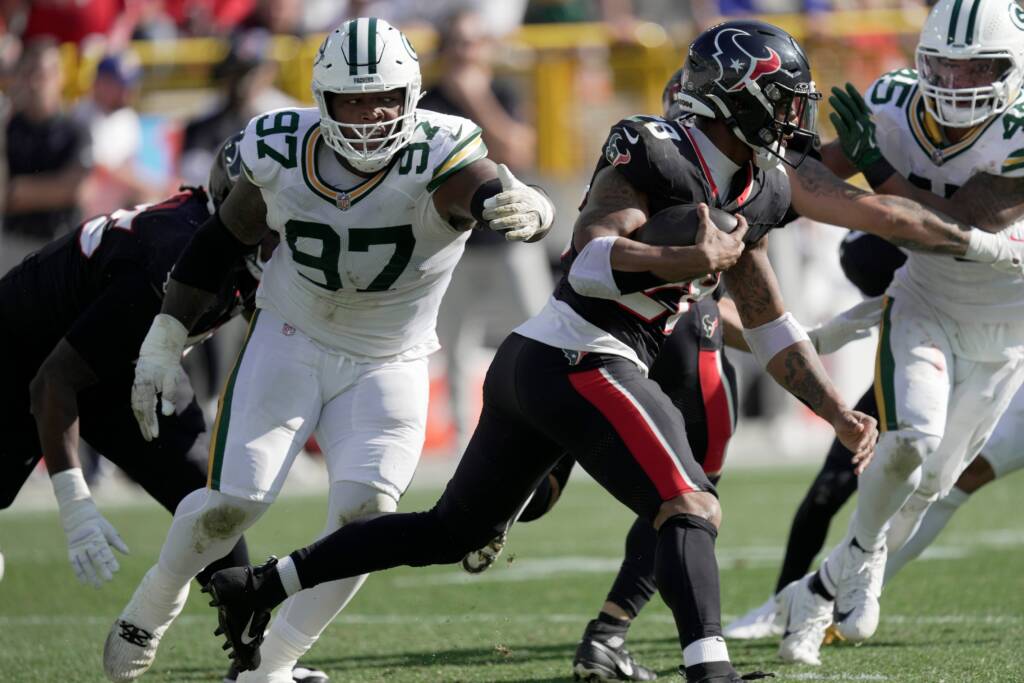The Green Bay Packers defense showed up against the Houston Texans, holding star quarterback C.J. Stroud to 10 for 21 passing for 86 yards — the lowest passing yardage of his young career. Green Bay’s defensive front got after Stroud early and often. The Packers got home consistently on Sunday, pressuring Stroud 48.3% of the time, and got home with 18 pressures and four sacks.
Ultimately, the day was so impactful for Green Bay’s pass rush because of a mixture of effectiveness on early downs, creative blitz looks, being able to push the line of scrimmage, and ineffective play by Houston’s offensive line.
So much of Green Bay’s success on Sunday started by winning first and second down. The defense generated 11 tackles for loss, which led to the Texans being consistently behind in down and distance. Specifically, Houston’s average third-down distance was almost seven yards, leading to them going four for 13 on third downs.
For instance, the Texans’ first drive to start the half, when they went three-and-out, was indicative of the day. It began with an amazing one-on-one win by Kenny Clark. He dominated former first-round pick Kenyon Green, who has struggled this year.
Then, the Texans faced a second-and-long play, on which Joe Mixon had a solid seven-yard run. That set up a third-and-medium and an obvious passing down, on which the Packers showed extra pressure. They ended up getting home with Eric Wilson‘s sack. The obvious passing situation and early down success set up the play and got Green Bay’s defense off the field.
Hafley continued to build in wrinkles and test Houston’s pass blocking. For instance, Wilson’s second sack (also on a third down) was an eerily similar look, showing blitz from both middle linebackers. However, they changed who came home on the blitz.
Here’s a look at both sacks back to back:
Hafley does a great job preparing his guys to play and putting stress on offenses. Rashan Gary had some illuminating comments about the pass rush after the game, saying they focus on “understanding how teams want to block our personnel, understand different types of personnel groups we want to show them, so just understand how they want to get it blocked up and a game plan to execute to beat that. That’s what today is.”
The comments — and the film — point to a defensive game plan that wanted to confuse and get favorable match-ups to turn up the heat on Stroud.
Three out of four of the Packers sacks came on critical third-down plays and got the offense back on the field. Undoubtedly, that’s a positive takeaway Green Bay can build on, and Hafley certainly earned the game ball he got after the victory.
However, the pass rush and pressure on the day isn’t all on the Packers. I’d describe Houston’s overall pass blocking as poor throughout the game. For instance, the offensive tackle slipped and fell on Gary’s sack before he could even attempt to block Gary.
Similarly, on Xavier McKinney’s sack, the Texans’ tight end opted to help the offensive tackle block and let McKinney have a straight line to the quarterback.
Ultimately, it was certainly one of the Packers’ better defensive efforts against tougher competition. Green Bay’s push along the defensive line led the way in getting tackles for loss and generating pressure. It’s something to build on and stack success upon for Jeff Hafley’s growing defensive unit.

